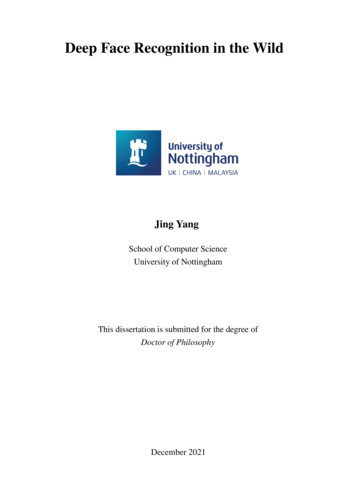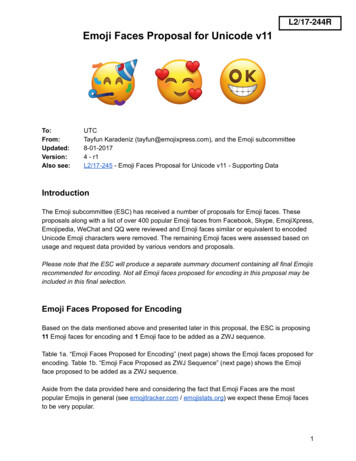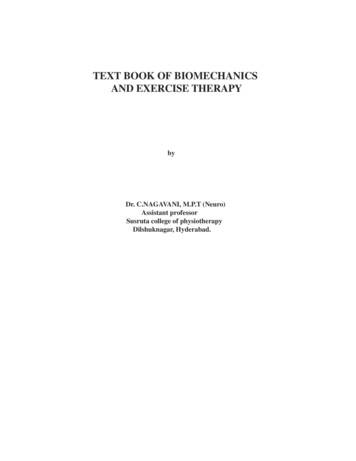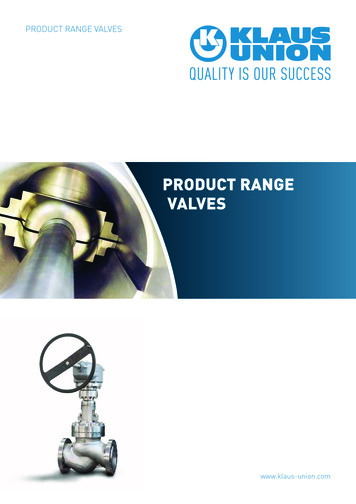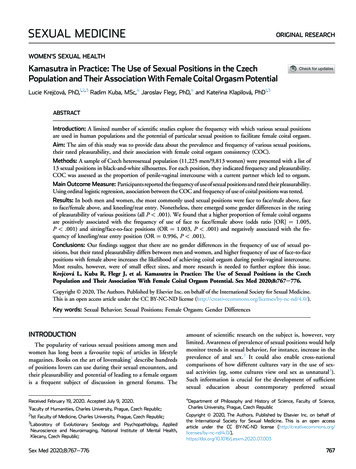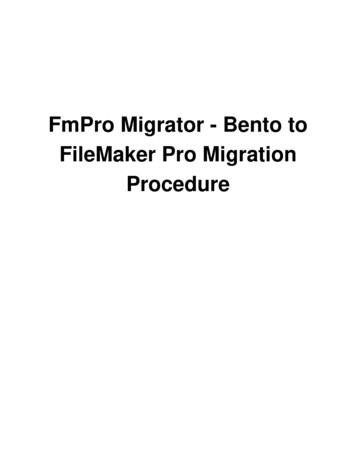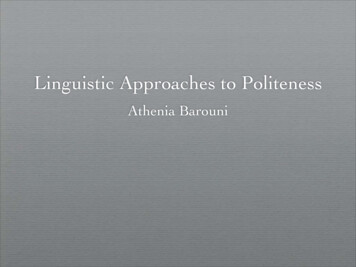
Transcription
Frontal to Profile Face Verification in the WildSoumyadip Sengupta1 , Jun-Cheng Chen1 , Carlos Castillo1 , Vishal M. Patel2 , Rama Chellappa1 , andDavid W. Jacobs112Center for Automation Research, University of Maryland, College Park, MD 20740, USA.Department of Electrical and Computer Engineering Rutgers, The State University of New Jersey,Piscataway, NJ 08854, USA.AbstractWe have collected a new face data set that will facilitateresearch in the problem of frontal to profile face verification ‘in the wild’. The aim of this data set is to isolate thefactor of pose variation in terms of extreme poses like profile, where many features are occluded, along with other ‘inthe wild’ variations. We call this data set the Celebritiesin Frontal-Profile (CFP) data set. We find that human performance on Frontal-Profile verification in this data set isonly slightly worse (94.57% accuracy) than that on FrontalFrontal verification (96.24% accuracy). However we evaluated many state-of-the-art algorithms, including FisherVector, Sub-SML and a Deep learning algorithm. We observe that all of them degrade more than 10% from FrontalFrontal to Frontal-Profile verification. The Deep learningimplementation, which performs comparable to humans onFrontal-Frontal, performs significantly worse (84.91% accuracy) on Frontal-Profile. This suggests that there is a gapbetween human performance and automatic face recognition methods for large pose variation in unconstrained images.1. IntroductionFace recognition for unconstrained images is a challenging problem, due to variation in pose, illumination, expression, age and occlusion. A significant challenge of posevariation occurs when features from the whole face are notvisible. These situations appear often in many real worldscenarios like, surveillance and photo-tagging, where it isquite natural for a person not to face the camera. In thispaper we plan to study the effect of pose variation, isolatedas a factor, in the presence of other ‘in the wild’ variations.One such case of interest is matching a frontal face facing acamera to a profile face facing away from the camera. Thefeatures available in both these views vary significantly andare therefore difficult to match.We define a ‘near profile’ pose as one that obscures manyfeatures; specifically the second eye. This roughly corresponds to yaw greater than 60 degrees. We define ‘nearfrontal’ as those cases where both sides of the face are almost equally visible and the yaw is within 10 degrees ofpurely frontal. The main motivation of this work is to studyface recognition in the presence of such extreme pose variation ‘in the wild’.Face recognition has changed significantly over the pastdecade. Starting with constrained, carefully acquired images, the community has turned its attention to the distinct problem of face recognition in unconstrained settings.There are many data sets that have aided this progress. Labeled Faces in the Wild (LFW) [17] was acquired to studythe problem of face recognition from unconstrained imagesand consists of images collected via the Internet. The Multipie [12] data set encourages face recognition in the presence of pose, illumination and expression variation in a controlled environment. One of the shortcomings of the LFWdata set is that it doesn’t offer a high degree of variation interms of pose, like the variation in pose present in Multipie.Large pose variation has been shown to be a major challenge in face recognition. In this paper we propose a newdata set, which in principle is a mixture of constrained andunconstrained settings. We collect images from the internet,which are unconstrained, but filter them out to match specific ‘frontal and ’profile’ poses. This allows us to studythe problem of pose variation in a more controlled waywhile all other variations are unconstrained. We call thisdata set ‘Celebrities in Frontal-Profile data set’ (CFP). Webelieve solving this problem with extreme pose variationwill bring more success to the general problem of unconstrained pose variation, especially in cases of surveillanceand photo-tagging.The data set contains 10 frontal and 4 profile images of
Figure 1. Sample Images from proposed Celebrities in Frontal-Profile (CFP) data set500 individuals. Similar to LFW, we have defined 10 splits,each containing 350 same and 350 not-same pairs. The taskis face verification.To understand how difficult the problem of frontal to profile comparison in the wild is compared to frontal to frontalunconstrained image recognition, as in LFW, we form twoseparate experiments of Frontal-Profile and Frontal-Frontalface verification. We evaluated some state-of-the-art facerecognition algorithms and human responses on this experiment to obtain a sense of the difficulty posed by thisnew data set. We found that humans achieve 94.57% accuracy on Frontal-Profile as compared to 96.24% on FrontalFrontal. On the other hand we observe that for most stateof-the-art algorithms, verification accuracy degrades at leastby 10% from Frontal-Frontal to Frontal-Profile, meaningthat the error rate more than doubles. We notice that amongdifferent types of hand-crafted features Fisher Vector [31]performs better than HoG [10] and LBP [1]. In restrictedsettings, Fisher Vector with a metric learning, SubSML [5],achieves 80.63% accuracy on Frontal-Profile and 91.3% accuracy on Frontal-Frontal. These findings show that facerecognition with large pose variation in an uncontrolled environment is still an open research problem. Our data setattempts to enable research in this important problem toachieve or surpass human accuracy on this task.Learning features via a deep neural network, has broughthuge success in unconstrained face recognition. Many ofthe current state-of-the-art deep learning implementations[33], [32], [27], are not publicly available. We used a deeplearning algorithm [9] which achieved near human accuracy (96.4%) on Frontal-Frontal face verification. Howevereven this algorithm falls short by 11% in accuracy (84.91%)on Frontal-Profile verification as compared to humans onthis task. This network was trained with approximately400K unconstrained images of around 10K subjects. Certainly one can try to train a network on profile images alone.However collecting millions of profile images, which moststate-of-the-art deep networks require for training, is difficult. For example, if we search ‘Google Image’ for profileimages of a person, less than 2% of top 100 images are actually profile. This means a huge amount on post-processingneeds to be done to remove wrong poses and identities tocollect millions of images. So can we do something better without trying to collect a huge number of profile images? This requires an advance in research in face recognition with large pose variation and our work is aimed toprovide a benchmark for these future researches.Most algorithms require some facial key-points either foraligning [33] or extracting features [5]. Current state ofthe art key-point detectors fail in the case of near profileposes. Along with the images, our data set provides handannotated key-points for profile faces to encourage researchin automatic key-point detection for profile faces.To summarize, frontal to profile face recognition in thewild is important because: It occurs commonly in many applications. The performance of existing algorithms degrades significantly when comparing frontal faces to profile facesin the wild. The performance of humans in frontal to profile facecomparisons is only slightly worse compared to frontalto frontal.In Section 2 we discuss some of the related work in automatic key-point extraction, face recognition across posevariation, recognition in real world images and some current data sets. Section 3 presents detailed discussion of
the proposed CFP data set. Section 4 discusses the algorithms, whose performance are compared on our proposedCFP data set, followed by their performance evaluation.2. Related WorkThe vast majority of face recognition methods that attempt to handle pose variation use key-points [5], [7], [33].Key-points are used to align the images, extract features atspecific locations and warp faces to a canonical view. Therehas been quite a bit of progress in automatic key-point detection and there are many publicly available key-point detection algorithms [3], [38] and [36]. State of the art methods perform very well on frontal images, but the accuracyof key-point detectors degrades as the yaw or pitch angleof the face increases. Motivated by the above observation,we include dense ground truth key-points with our data set,so that face recognition across pose can improve while keypoint detectors get to the point where they can handle thefull spectrum of pose variation. Also these manually annotated key-points serve as a benchmark for future researcherstrying to develop automatic key-point extraction algorithmsfor profile faces.In addition to facial key-point detection, in this sectionwe will discuss two streams of work: (1) face recognitionwith pose variation and (2) face recognition ‘in the wild’.The first line of work in general depends on carefully acquired constrained image data sets that focus on pose, illumination and expression variations. Some important datasets along these lines are Yale-B [11], FERET [24], CMUPIE [30] and Multipie [12]. The second line of workis developed around data sets which contain unconstrainedimages. Labeled Faces in the Wild (LFW) [17] has become the de facto benchmark for face recognition in unconstrained settings. Average results on this data set haveincreased from 70% to 99% in the past 8 years. The LFWdata set is based on a face verification protocol, in restrictedand unrestricted settings. In the restricted setting, one isonly allowed to use pair-wise information provided in thesplits. However, in unrestricted setting, one can use identityinformation to build additional pairs not explicitly listed inthe training data or use outside training data. Some otherdata sets which also provide unconstrained images are PubFig [19] and the YouTube Face data set (YTF) [35].Face Recognition across pose : Researchers have usedseveral different approaches to solve the problem of facerecognition with pose variation. One such popular technique is to fit a Morphable model to the face and warp itto some canonical view. This line of work started in [4]and exploded as a general model fitting technique; for example Generic Elastic Models (GEM) [25] and Active Appearance based Models for Pose normalization [2]. However these methods tend to work well for small degrees ofpose variation and for faces without ‘in the wild’ variation.Another type of methods are based on subspace learning.These methods mostly use Canonical Correlation Analysis(CCA) [14] or Partial Least Square (PLS) [29]. Recently[20] and [28] (27.1% identification accuracy for FrontalProfile in Multipie) have shown good results over the Multipie and CMU PIE data sets, considering an identificationprotocol rather than verification. However it has not beendemonstrated that these methods will actually work for ‘inthe wild’ images. Another direction of pose invariant research is to develop a method to directly compare faces intwo poses using stereo matching [6], which performs wellshort of state-of-the-art on real world images such as thosein the LFW data set. Another line of pose invariant facerecognition research deals with generative models. Thesemethods assume that there is a latent factor that producesdifferent identities and different poses are generated by another latent variable. Recently [26] have shown good performance in constrained data sets such as FERET [24].Along the same line [22] produced good results on unconstrained data set like LFW (90.07% verification accuracy inunrestricted setting). Attribute based recognition [19] isanother approach to the problem, which is also potentiallyinvariant to pose variation, although it is not clear that attributes can be obtained as accurately on profile faces as onfrontal faces. Most of these method depend on good alignment across pose, which is hard to obtain for our proposedCFP data set.Face Recognition on unconstrained images : In thissection we discuss those methods that have produced goodperformance over the LFW data set and other ‘in the wild’data sets. One general technique adopted by many researchers is to develop metric learning approaches that canlearn a transformation of the feature space to reduce thevariability, which is important for unconstrained images.Cosine Similarity metric learning [23] and Similarity metric learning [5] (86.73% in unrestricted setting) have produced good results on the LFW data set. Researchers havealso developed other metric learning approaches [13], [18]along with Deep metric learning approaches [15] [16]. TheJoint Bayesian model [7] (90.90% accuracy in unrestrictedsetting) and [8] (93.18% accuracy) performs well on LFW.However these methods generally need identity informationduring training and thus can only be used with the unrestricted protocol (where one can use identity information oroutside training data).Researchers have also concentrated on feature extraction techniques other than traditional SIFT, LBP or HoGto provide a higher level representation. One such efficient method uses Fisher Vector encoding [31] (87.47%in restricted settings) and [21] (84.08% in restricted settings). However they are not robust against large pose variation. Researchers have moved from hand crafted features totrained features using Deep networks namely CNNs (Con-
volutional Neural Networks). Some successful applicationsare Deepface [33] (97.35%), DeepID [32] (99.47%) andFaceNet [27] (99.63%), which have shown to be the current state of the art among algorithms on LFW in the unrestricted setting with outside training data. Since most ofthese algorithms are not publicly available, we used a different deep learning technique [9] for extracting features.We show that it performs as humans on Frontal-Frontal butfalls short by a large margin on Frontal-Profile compared tohumans. However this network is trained on unconstrainedimages. One can certainly try to train a network on a largeamount of profile images, which is very difficult to collect.It will be also interesting to observe how researchers comeup with new methods that can tackle pose variation withoutexplicitly collecting millions of profile images.Figure 2. key-points for Frontal-Profile Images3. Celebrities in Frontal-Profile data setWe have collected a data set of unconstrained faces inboth frontal and profile poses. The experimental protocolis built upon face verification. Unlike LFW, we decided tobalance the data set by choosing only a fixed number offrontal and profile images per individual. We will make thisdata set publicly available.3.1. Collection Set-upTo collect our data set we started by generating a listof individuals. We decided to maintain balance in the dataset by choosing almost equal numbers of males and females and maintaining as much racial diversity as possible. We chose a roughly balanced set of politicians, athletes and entertainers. In order to collect frontal and profileimages we downloaded hundreds of images of each individual for frontal and profile respectively. To search for profileimages, we used keywords ‘profile face’ and ‘side view’.Though most of the frontal images are correct in terms ofpose or identity, there were lots of non-profile images in thedownloaded profile images. Next we cleaned up the data setby deleting incorrect identities and poses by using AmazonMechanical Turk. We defined ‘frontal’ pose as those imageswhere both sides of the face are almost the same area of theimage and ‘profile’ pose as those images where one eye iscompletely visible and less than half of the second eye isvisible. Roughly, these definitions mean : within 10 degrees yaw variation for ‘frontal’ and more than 60 degreesyaw variation for ‘profile’. To make this technical criteriaclear we provided example images to the Amazon Mechanical Turk workers for reference. We also ran a face detector[38] to further verify that these images are indeed faces andthey satisfy the yaw variation constraints. We have a totalof 500 individuals and we choose to keep 10 frontal and 4profile images per person in the data set.We crop the frontal images by running a face detector[3]. However these state-of-the-art face detectors performFigure 3. Amazon Mechanical Turk window for obtaining humanperformance on CFP data setimperfectly on our profile images. Then we set up an Amazon Mechanical Turk job where we asked workers to manually crop the faces from all the profile image. For frontalimages we extract key-points by running a facial key-pointdetector [3]. However none of the state-of-the-art detectors, that we tried [38], [3], work well for profile faces.We acquired labeled key-points from workers via AmazonMechanical Turk. We present the workers with examples ofmanually clicked profile key-points and ask them to markthe same. Since in profile only one side of the face is visible, we choose to keep key-points only on one side forfrontal faces also. This is to ensure that we always havecorrespondence in key-points across all images. An example of key-points in frontal and profile is shown in Figure2. Based on the key-points both the frontal and profile images are cropped. We create a tight bounding box on theface based on the key-points and enlarge it consistently toaccommodate large regions of the face.3.2. Experimental ProtocolWe divide the data into 10 splits with a pairwise disjoint set of individuals in each split. For each split we have50 individuals. We randomly generate 7 same and 7 notsame pairs for each individual, thus producing 350 sameand 350 not-same pairs per split. This is done both forFrontal-Frontal and Frontal-Profile experiments. In the end,we have 7000 pairs of faces for both Frontal-Frontal andFrontal-Profile experiment. Note that our choice of generating pairs in the split is balanced in terms of number of pairs
Figure 4. Human performance on CFP data set. (Top row) Top 3 mistakes on same-pairs. (Bottom row) Top three mistakes on not-samepairs. Higher score means more similar in a scale of 1-5.per person, unlike LFW and YTF data set. Like LFW, theprotocol is to test on one split while training on the remaining nine. Unlike LFW, we do not have separate View 1 andView 2 (two views are provided in LFW to develop modelsand validate on one view and finally test on another), dueto a lack of data (as collecting profile images is more difficult), therefore similar to YTF we only have one view. Foreach split the evaluator is allowed to choose the parameterof the classifier via cross-validation over the training dataset only. We report the average Accuracy, Equal Error Rate(EER), Area Under the Curve (AUC) and the ROC curve.Similar to LFW, there can be a ‘restricted’ setting, wherethe evaluator is only allowed to use same-different pairs intraining the classifier and ’unrestricted’ setting, where theevaluator can use identity labels of the training images. Onecan have two more variations depending on the use of outside training images which is of special interest in ‘unrestricted’ settings. In our experiments we used a ‘restrictedno outside image’ protocol for all algorithms except thedeep learning implementation. Deep learning implementation uses ’outside training image’ to train the network,but the cosine-similarity metric only uses the same-differentpairs of the CFP data set.3.3. Human PerformanceOnce the data set is ready we ask the next question, howgood are humans on this task? In [19], the authors evaluated human performance on the LFW data set. Humans performed 97.53% on cropped images of LFW. We expectedFrontal-Profile verification to be harder than LFW evalu-ation. With similar cropped images we note that humansperform 94.57% on the frontal-profile experiment in comparison to 96.24% on frontal-frontal experiment of our CFPdata set. We note that the degradation of human performance from LFW to the CFP frontal-profile data set is significantly less than what state-of-the-art algorithms show.This also indicates the need for research to tackle large posevariation.To provide a sense of how hard the problem is for humans, we show in Figure 4 the top mistakes made by humans on Frontal-Profile. Each Mechanical Turk workerscores each image on a scale of 1-5, where higher scoremeans more similar. We show top three mistakes from samepair and not-same pair in the image.Human experiments are performed via Amazon Mechanical Turk. We show each pair of images to 5 workers whomay or may not be familiar with the individual being depicted. We then ask each of them to rate the similarity between pairs on a scale 1 to 5 (where 1 is definitely differentand 5 is definitely same). This shows the confidence of thedecision from the user. We remove any outlier or erroneousworkers and average out their scores to produce the final accuracy and ROC curve. The interface for human evaluationis very simple as depicted in figure 3.4. Experimental EvaluationTo show the difficulty posed by Frontal-Profile verification in our CFP data set, we evaluate numerous state-of-theart algorithms on this data set. We look at those algorithms
that perform well on unconstrained or ‘in wild’ data sets likeLFW and whose implementations are publicly available.We consider different types of feature extraction techniqueslike HoG [10], LBP [1] and Fisher Vector [31] along withdifferent metric learning techniques like Sub-SML [5] andothers as reported in [31]. Sub-SML [5] appears to be verysuccessful metric learning technique compared to others onthe LFW data set. We run the experiment on both FrontalFrontal and Frontal-Profile in ‘restricted’ settings. We alsoused a Deep learning implementation [9] which uses outside images for training the network.than Sub-SML we use Diagonal metric learning (DML) asreported in [31]. We should point out the differences between these different techniques. Diagonal Metric Learning(DML) is learning to weight different feature dimensions,which can be implemented via a linear SVM formulation.Sub-SML learns both a distance metric along with a similarity kernel, and includes a regularization in the formulation, which penalizes too much distortion of these matricesand is implemented via a fast first order method.4.1. AlgorithmsWe present the mean and standard deviation of Accuracy, Equal Error Rate (EER) and Area Under Curve (AUC)over the 10 fold experiments for both Frontal-Profile andFrontal-Frontal Experiment in Table 1 and also present theaverage ROC curves for them in Figure 5.We use three different types of feature extraction techniques, the details of which are discussed below : HoG : We extract square patches of width 10, 15, 30,50 pixels centered around each of the 30 facial keypoints. Then we extract HoG features of cell-size 8from these patches and concatenate them to form a 53kdimensional HoG feature of the face. Multiple-scalepatches are used to provide a multi-resolution view ofthe face. We use the VLFeat [34] implementation ofHoG. LBP : Similar to HoG we extract square patches ofsize 10, 15, 30, 50 and 100 pixels centered around 30key-points. We then extracted uniform LBP features(sampling points 16) of radius 1 and concatenate themto form a 36k dimensional LBP feature of the face. Fisher Vector : We used publicly available code ofFisher Vector and followed the same principle of [31].However we didn’t use horizontal flipping of imagesto make it consistent with other features. Fisher vectorencoding with 512 cluster centers result in a 67,584dimensional feature. Deep features : We use the trained network reportedin [9]. The authors use a deep network with 10 convolution layers, 5 pooling layers and 1 fully connectedlayer. The receptive field of the CNN is 100 100 1.The authors claim that a deeper network with a smallernumber of filters is easier to train because it uses fewerparameters and performs better due to high amount ofnon-linearity. The network is trained on the CASIAWebface data set [37] with 494,414 images of 10,575subjects. We only used the network to extract featuresof dimension 320. We used a simple Cosine similaritymeasure over this feature.We use different types of classifiers, mainly based onmetric learning. We use publicly available code of SubSML [5]. All the features are reduced by PCA to 300dimension, whitened and then used with Sub-SML. Other4.2. Results4.3. DiscussionFrom the experimental results we can observe the significant drop in performance of all the algorithms from FrontalFrontal to Frontal-Profile. On the other hand, human performance only deteriorates around 2% from Frontal-Frontal toFrontal-Profile. However most of the algorithms degradearound 10%. For Frontal-Frontal, Deep features producenear-human accuracy. Whereas for Frontal-Profile it fallsshort of human performance by 11%. This means eventhough the problem is hard for humans, they perform wellcompared to current state-of-the-art algorithms. Thus thereis a huge room for improvement.In the restricted protocol, we can see that Fisher Vectorwith Sub-SML performs best of all the algorithms. We canobserve that Fisher vector is a much better feature than HoGand LBP as it is more robust to pose variation. Also HoGand LBP features used in the baseline, need dense sets of 30facial key-point to extract patches, whereas Fisher Vectoronly needs 3 key-points for rough alignment. We also compare different metric learning algorithms with Fisher vectoras the feature. We note that Sub-SML is much better asa metric learning method due to the regularization used inthe formulation. Diagonal Metric Learning (DML) formulation performs significantly worse in Frontal-Profile thanin Frontal-Frontal.We are not able to test state-of-the-art deep learning techniques on LFW, on our CFP data set since they are not publicly available and cannot be replicated with existing publicdata sets and available resources. We used a deep learning implementation [9], which achieves human accuracyon the Frontal-Frontal data. However it falls far short ofhuman accuracy on Frontal-Profile. It would be interestingto observe the performance of current state-of-the-art deeplearning methods on our CFP data set.In training the deep network [9], the author used 7key-points on both sides of the face to align the images.
Table 1. Performance comparison on CFP data set (Mean Accuracy and standard deviation over 10 folds)AlgorithmHoG Sub-SMLLBP Sub-SMLFV Sub-SMLFV DMLDeep featuresHumanAccuracy77.31 (1.61 )70.02 (2.14)80.63 (2.12)58.47 (3.51)84.91 (1.82)94.57 (1.10)Frontal-ProfileEER22.20 (1.18)29.60 (2.11)19.28 (1.60)38.54 (1.59)14.97 (1.98)5.02 (1.07)AUC85.97 (1.03)77.98 (1.86)88.53 (1.58)65.74 (2.02)93.00 (1.55)98.92 (0.46)(a)Accuracy88.34 (1.33)83.54 (2.40)91.30 (0.85)91.18 (1.34)96.40 (0.69)96.24 (0.67)Frontal-FrontalEER11.45 (1.35)16.00 (1.74)8.85 (0.74)8.62 (1.19)3.48 (0.67)5.34 (1.79)AUC94.83 (0.80)91.70 (1.55)96.87 (0.39)97.25 (0.60)99.43 (0.31)98.19 (1.13)(b)Figure 5. Roc curve for (a) Frontal-Profile and (b) Frontal-FrontalHowever in profile faces, key-points from both sides arenot available. In future we plan to find a way to performthis alignment and fine-tune two separate deep networks onFrontal and Profile images of the data set to improve theperformance. There is also further possibility to train metric learning over these features. Sub-SML produced worseresult than simple cosine similarity over deep features.5. ConclusionThis work introduces a new data set which aims to enable the study of face recognition in unconstrained imageswith large pose variation. We analyzed the performance ofseveral different algorithms using a restricted protocol andshowed how all of them degrade from Frontal-Frontal toFrontal-Profile. We also used a deep learning based algorithm and showed that it fails to achieve near-human performance in Frontal-Profile unlike Frontal-Frontal. Howeverthere are many alternate ways to improve the trained deepnetwork by separately fine-tuning it over Frontal and Profileimages and training additional metric learning approachesover deep features. We plan to address these issues in future and try to develop good deep learning architectures thatcan handle pose variation without explicitly using millionsof Profile images. Our data set also provides this opportunity to other researchers. The gap between current state-ofthe-art algorithms on this data set and human performancesuggests that there is a lot of room for improvement.6. AcknowledgmentsThis research is based upon work supported by the Office of the Director of National Intelligence (ODNI), Intelligence Advanced Research Projects Activity (IARPA),via IARPA R&D Contract No. 2014-14071600012. Theviews and conclusions contained herein are those of the authors and should not be interpreted as necessarily representing the official policies or endorsements, either expressedor implied, of the ODNI, IARPA, or the U.S. Government.The U.S. Government is authorized to reproduce and distribute reprints for Governmental purposes notwithstandingany copyright annotation thereon.We thank Mr. Wasif Sikder for assistance with collectionof the data set.
References[1] T. Ahonen, A. Hadid, and M. Pietikainen. Face descriptionwith local binary patterns: Application to face recognition.Pattern Analysis and Machine Intelligence, IEEE Transactions on, 28(12):2037–2041, 2006.[2] A. Asthana, T. K. Marks, M. J. Jones, K. H. Tieu, and M. Rohith. Fully automatic pose-invariant face recognition via 3dpose normalization. In Computer Vision (ICCV), 2011 IEEEInternational Conference on, pages 937–944. IEEE, 2011.[3] A. Asthana, S. Zafeiriou, S. Cheng, and M. Pantic. Robust discriminative response map fitting with constrainedlocal models. In
in Frontal-Profile (CFP) data set. We find that human per-formance on Frontal-Profile verification in this data set is only slightly worse (94.57% accuracy) than that on Frontal-Frontal verification (96.24% accuracy). However we eval-uated many state-of-the-art algorithms, including Fisher Vector, Sub-SML and a Deep learning algorithm. We ob-
